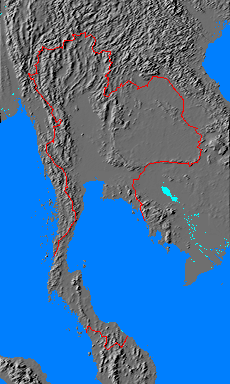![]() The Pacific War Online Encyclopedia
The Pacific War Online Encyclopedia
|
| Previous: Teshima Fusataro | Table of Contents | Next: Thanjavar |

Thailand was the only nominally independent nation in southeast Asia in 1941. Thai independence suited both Britain and France, who saw obvious advantages in having a neutral buffer state between Burma and French Indochina. However, informal British influence in Thailand prior to the 1930s, exercised through a system of powerful advisers and economic ties, was sufficient that Thailand was considered an integral part of the British Imperial defense perimeter. Thailand was part of the sterling block and 70% of its exports were in the form of rice shipped to Malaya in jute bags supplied from India. The modest amounts of tin mined in Thailand were smelted exclusively in British refineries.
The Japanese attempted to draw Thailand into their sphere of influence prior to the war. However, their diplomacy was clumsy and overbearing, and Thai attitudes towards Japan were characterized more by fear than by admiration. Thai irredentist ambitions on areas of French Indochina conflicted with Japan's commitments to the Vichy regime, and Japan intervened on behalf of Thailand in a 1940 border clash only with reluctance and after the Thais had already gained the upper hand.
Thailand was courted by both the Axis and the Allies up until the very eve of war in the Pacific, when Japan delivered an ultimatum demanding, at a minimum, unhindered passage for troops on their way to Malaya and Burma. Three Thai pilots who insisted on engaging a Japanese aircraft formation that had entered Thai airspace were promptly shot down. Churchill's counter offer of support did not arrive until after the Thai government had capitulated to the Japanese demands. Thai border guards barricaded the roads into Thailand from Malaya and fired on British troops attempting to move against Japanese landings at Patani and Singora, and Thai troops attacked regions of Burma (primarily in the Shan States) inhabited by ethnic Thais that were claimed by Thai irredentists.
Thailand formally declared war on the Allies on January 25, 1942. The British government returned the compliment, but the Americans took the official position that the Thais had acted under duress, which may not have been too far from the truth: The Thai ambassador refused to deliver the declaration of war to the U.S. government and remained at his post throughout the war. However, in late April 1942 delegates from Thailand negotiated a treaty of alliance with the Japanese whose terms included, among other things, Thai support for the Burma-Siam Railroad.
On 4 July 1943, Tojo
visited Thai dictator Phibul Songkram
and promised to restore "lost" provinces in Malaya and Burma. This
reflected a growing Japanese appreciation of Allied power and a
need to make Thailand the core of a Southeast Asian redoubt
against an Allied counteroffensive.
Thai forces in 1943 amounted to seven infantry divisions, two cavalry regiments, two antiaircraft regiments, a
mechanized infantry regiment, and a smattering of other supporting
elements.
Except for some bombing raids on the rail yards of Bangkok, and air activity over the large air base at Chiengmai in northern Thailand, the war largely passed Thailand by.
References
Niehorster (2011; accessed 2011-8-26)
The Pacific War Online Encyclopedia © 2006, 2008, 2010-2011, 2015-2016 by Kent G. Budge. Index